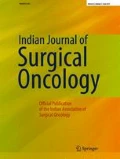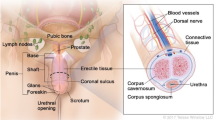Abstract
Penile cancer is more prevalent in India than in the West. Also, the usual stage at the presentation is more advanced in our country. Over the years, there have been various advancements in the diagnosis and management. Evolving concepts like penile preservation to improve quality of life, use of biomarkers to prognosticate, refinement in techniques of sentinel lymph node biopsy, and better evidence for neoadjuvant and adjuvant treatment have been dealt with in this review. This review also highlights the gaps and potential areas of research in management of this disease.
Similar content being viewed by others
Reference
Indian Council of Medical Research (ICMR), National Cancer Registry Programme. Consolidated Report of the Population based cancer registries 1990–1996(2001), New Delhi: ICMR Publication: 114–224.
NCRP-ICMR -Three Year Report of PBCR 2012–2014
Tsen HF et al (2001) Risk factors for PCa: results of a population-based case-control study in Los Angeles County (United States). Cancer Causes Control 12:267
Thuret R et al (2013) A population-based analysis of the effect of marital status on overall and cancer-specific mortality in patients with squamous cell carcinoma of the penis. Cancer Causes Control 24:71
Engels EA, Pfeiffer RM, Goedert JJ et al (2006) Trends in cancer risk among people with AIDS in the United States 1980–2002. AIDS 20(12):1645–1654
Chaux A, Pfannl R, Rodríguez IM et al (2011) Distinctive immunohistochemical profile of penile intraepithelial lesions: a study of 74 cases. Am J Surg Pathol 35:553–562
Li ZS, HanH ZZJ, Zhou FJ, Qin ZK, Liu W, Yao K (2014) Modified pathological N2 staging system in prognosis prediction of PCa patients. Chinese Journal of Cancer Prevention and Treatment 21(4):300–303
Kirkham A (2012) MRI of the penis. Br J Radiol 85:S86–S93
Caso JR, Rodriguez AR, Correa J, Spiess PE (2009) Update in the management of PCa. Int Braz J Urol 35(4):406–415
Sheng Zhang, Wenfeng Li, Fei Liang (2016) Clinical value of fluorine-18 2-fluoro-2-deoxy-D-glucose positron emission tomography/computed tomography in PCa. Oncotarget. May 14.
Backes DM, Kurman RJ, Pimenta JM et al (2009) Systematic review of human papillomavirus prevalence in invasive PCa. Cancer Causes Control 20:449–457
Lont AP, Kroon BK, Horenblas S et al (2006) Presence of high-risk human papillomavirus DNA in penile carcinoma predicts favorable outcome in survival. Int J Cancer 119:1078–1081
Weaver BA, Feng Q, Holmes KK et al (2004) Evaluation of genital sites and sampling techniques for detection of human papillomavirus DNA in men. J Infect Dis 189:677–685
Saibishkumar EP, Crook J, Sweet J (2008) Neonatal circumcision and invasive squamous cell carcinoma of the penis: a report of 3 cases and a review of the literature. Can Urol Assoc J 2:39–42
Giuliano AR, Palefsky JM, Goldstone S et al (2011) Efficacy of quadrivalent HPV vaccine against HPV infection and disease in males. N Engl J Med 364:401–411
Kayes O et al (2007) Molecular and genetic pathways in PCa. Lancet Oncol 8:420
Hegarty PK, Kayes O, Freeman A et al (2006) A prospective study of 100 cases of PCa managed according to European Association of Urology guidelines. BJU Int 98:526–531
Vuichoud C, Loughlin KR (2016) The emerging role and promise of biomarkers in PCa. Urol Clin N Am 43:135–143
Zhu Y, Ye DW, Yao XD et al (2008) The value of squamous cell carcinoma antigen in the prognostic evaluation, treatment monitoring and follow-up of patients with PCa. J Urol 180:2019–2023
Stankiewicz E, Ng M, Cuzick J et al (2012) The prognostic value of Ki-67 expression in penile squamous cell carcinoma. J Clin Pathol 65:534–537
Gentile V, Vicini P, Giacomelli L et al (2006) Detection of human papillomavirus DNA, p53 and ki67 expression in penile carcinomas. Int J Immunopathol Pharmacol 19:209–215
Ficarra V et al (2010) Prognostic factors in PCa. Urology Aug 76(2 Suppl 1):S66–S73
Cubilla AL (2009) The role of pathologic prognostic factors in squamous cell carcinoma of the penis. World J Urol 27:169
Rees R.W.et al. (2008) pT2 penile squamous cell carcinomas: cavernosus vs. spongiosus invasion. Eur Urol Suppl 7: 111
Hungerhuber E et al (2006) Risk stratification in penile carcinoma: 25-year experience with surgical inguinal lymph node staging. Urology 68:621
Li ZS et al (2014) Disease-specific survival after radical lymphadenectomy for PCa: prediction by lymph node count and density. Urol Oncol Aug 32(6):893–900
Li Z-S et al (2016) Development of a new classification method for penile squamous cell carcinoma based on lymph node density and standard pathological risk factors: the ND staging system. J Cancer 7(3):262–267
Chaux A et al (2009) The prognostic index: a useful pathologic guide for prediction of nodal metastases and survival in penile squamous cell carcinoma. Am J Surg Pathol 33:1049
Arthur L. Burnett (2016) Penile preserving and reconstructive surgery in the management of PCa; Nature Reviews | Urology Volume 13 May; 249–57
Kroon BK, Horenblas S, Lont A et al (2005) Patients with penile carcinoma benefit from immediate resection of clinically occult LNM. J Urol 173:816–819
Protzel C et al (2009) Lymphadenectomy in the surgical management of PCa. Eur Urol 55:1075–1088
Leijte JAP, Kroon BK, Valdés Olmos RA, Nieweg OE, Horenblas S (2007) Reliability and safety of current dynamic sentinel node biopsy for penile carcinoma. Eur Urol 52:170–177
Neto AS, Tobias-Machado M, Ficarra V et al (2011) Dynamic sentinel node biopsy for inguinal lymph node staging in patients with PCa: a systematic review and cumulative analysis of the literature. Ann Surg Oncol 18:2026–2034
Lam W et al (2013) Dynamic sentinel lymph node biopsy in patients with invasive squamous cell carcinoma of the penis: a prospective study of the long-term outcome of 500 inguinal basins assessed at a single institution. Eur Urol 63:657–663
Dimopoulos P, Christopoulos P, Shilito S et al (2016) Dynamic sentinel lymph node biopsy for PCa: a comparison between 1- and 2-day protocols. BJU Int 117:890–896
Carlone M et al (2016) CT-based planning and Monte Carlo dosimetry for penile brachytherapy. Brachytherapy Volume 15(Supplement 1):S155
Pagliaro LC et al (2010) Neoadjuvant paclitaxel, Ifosfamide, and cisplatin chemotherapy for metastatic PCa: a phase II study. J Clin Oncol Aug 20 28(24):3851–3857
O.W. Hakenberg, E. Compérat, S. Minhas, A. Necchi, C. Protzel, N. Watkin (2016) European Association of Urology Guidelines on Penile cancer
Pizzocaro G, Piva L, Bandieramonte G, Tana S (1997) Up-to-date management of carcinoma of the penis. Eur Urol 32(1):5–15
Noronha V et al (2012) Role of paclitaxel and platinum-based adjuvant chemotherapy in high-risk PCa. Urol Ann 4:150
Pond GR et al (2014) Concurrent chemoradiation therapy for men with locally advanced penile squamous cell carcinoma. Clinical Genitourinary Cancer Vol. 12(6):440–446
Patil VM et al (2014) Palliative chemotherapy in carcinoma penis: does platinum and taxane combination holds a promise? Urology Annals Jan - Mar Vol 6(1):18–22
Author information
Authors and Affiliations
Corresponding author
Rights and permissions
About this article
Cite this article
Mahendra, P., Ganesh, B., Gagan, P. et al. What Is New in the Diagnosis and Management of Penile Cancer?. Indian J Surg Oncol 8, 379–384 (2017). https://doi.org/10.1007/s13193-016-0613-2
Received:
Accepted:
Published:
Issue Date:
DOI: https://doi.org/10.1007/s13193-016-0613-2



